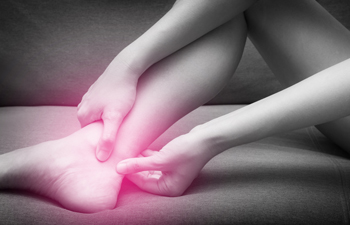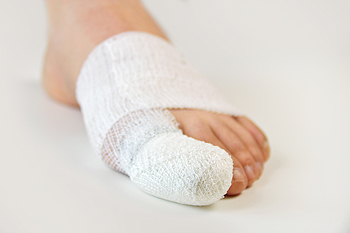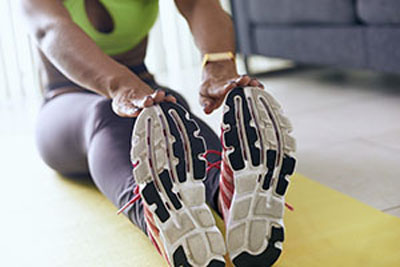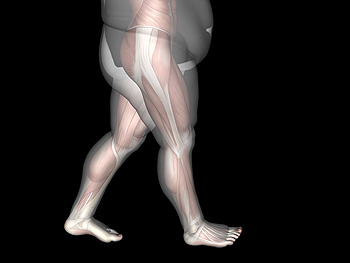Connect With Us
Blog
Items filtered by date: August 2020
Treatments for Tarsal Tunnel Syndrome
 Tarsal tunnel syndrome is a nerve disorder that causes pain in the foot and ankle. It may also cause a burning or tingling sensation or numbness when walking, standing, or wearing certain shoes . This is due to the compression of the posterior tibial nerve, a nerve that runs through a canal near the heel into the sole of the foot. Repetitive stress, injuries, having flat feet, being overweight, or having a lesion near the tarsal tunnel area can cause inflammation of the surrounding tissue and nerve compression. There are a variety of treatments for tarsal tunnel syndrome. A doctor may recommend resting and icing the affected foot and taking oral medication to decrease pain and inflammation. In some cases, immobilizing the foot or using an orthotic device can help. Decompression surgery may be necessary in more severe cases. If you suspect you may have tarsal tunnel syndrome, consult with a podiatrist for diagnosis and treatment.
Tarsal tunnel syndrome is a nerve disorder that causes pain in the foot and ankle. It may also cause a burning or tingling sensation or numbness when walking, standing, or wearing certain shoes . This is due to the compression of the posterior tibial nerve, a nerve that runs through a canal near the heel into the sole of the foot. Repetitive stress, injuries, having flat feet, being overweight, or having a lesion near the tarsal tunnel area can cause inflammation of the surrounding tissue and nerve compression. There are a variety of treatments for tarsal tunnel syndrome. A doctor may recommend resting and icing the affected foot and taking oral medication to decrease pain and inflammation. In some cases, immobilizing the foot or using an orthotic device can help. Decompression surgery may be necessary in more severe cases. If you suspect you may have tarsal tunnel syndrome, consult with a podiatrist for diagnosis and treatment.
Tarsal tunnel syndrome can be very uncomfortable to live with. If you are experiencing tarsal tunnel syndrome, contact one of our podiatrists of Florida Foot & Ankle Group, P.A.. Our doctors can provide the care you need to keep you pain-free and on your feet.
Tarsal Tunnel Syndrome
Tarsal tunnel syndrome, which can also be called tibial nerve dysfunction, is an uncommon condition of misfiring peripheral nerves in the foot. The tibial nerve is the peripheral nerve in the leg responsible for sensation and movement of the foot and calf muscles. In tarsal tunnel syndrome, the tibial nerve is damaged, causing problems with movement and feeling in the foot of the affected leg.
Common Cause of Tarsal Tunnel Syndrome
- Involves pressure or an injury, direct pressure on the tibial nerve for an extended period of time, sometimes caused by other body structures close by or near the knee.
- Diseases that damage nerves, including diabetes, may cause tarsal tunnel syndrome.
- At times, tarsal tunnel syndrome can appear without an obvious cause in some cases.
The Effects of Tarsal Tunnel Syndrome
- Different sensations, an afflicted person may experience pain, tingling, burning or other unusual sensations in the foot of the affected leg.
- The foot muscles, toes and ankle become weaker, and curling your toes or flexing your foot can become difficult.
- If condition worsens, infections and ulcers may develop on the foot that is experiencing the syndrome.
A physical exam of the leg can help identify the presence of tarsal tunnel syndrome. Medical tests, such as a nerve biopsy, are also used to diagnose the condition. Patients may receive physical therapy and prescriptive medication. In extreme cases, some may require surgery.
If you have any questions please feel free to contact one of our offices located in Debary, Lake Mary, Orlando, and Oviedo, FL . We offer the newest diagnostic and treatment technologies for all your foot and ankle needs.
Is My Toe Broken?
 There are many signs that can indicate if a person has broken their toe. Common symptoms of a broken toe can include pain when the affected toe is touched, difficulty walking, as well as swelling and bruising. Bruising can appear with vivid discoloration if the injury is extreme. Sometimes the toenail of the affected toe can become severely damaged and show abnormalities if a break has occurred. Blood may become trapped under the toenail causing discoloration. More noticeably, you may see a bone protrude from the affected toe. If you believe you have a broken toe, it’s important that you visit a podiatrist who can provide a proper diagnosis and an advised treatment plan.
There are many signs that can indicate if a person has broken their toe. Common symptoms of a broken toe can include pain when the affected toe is touched, difficulty walking, as well as swelling and bruising. Bruising can appear with vivid discoloration if the injury is extreme. Sometimes the toenail of the affected toe can become severely damaged and show abnormalities if a break has occurred. Blood may become trapped under the toenail causing discoloration. More noticeably, you may see a bone protrude from the affected toe. If you believe you have a broken toe, it’s important that you visit a podiatrist who can provide a proper diagnosis and an advised treatment plan.
Broken toes may cause a lot of pain and should be treated as soon as possible. If you have any concerns about your feet, contact one of our podiatrists from Florida Foot & Ankle Group, P.A.. Our doctors will treat your foot and ankle needs.
What Is a Broken Toe?
A broken toe occurs when one or more of the toe bones of the foot are broken after an injury. Injuries such as stubbing your toe or dropping a heavy object on it may cause a toe fracture.
Symptoms of a Broken Toe
- Swelling
- Pain (with/without wearing shoes)
- Stiffness
- Nail Injury
Although the injured toe should be monitored daily, it is especially important to have a podiatrist look at your toe if you have severe symptoms. Some of these symptoms include worsening or new pain that is not relieved with medication, sores, redness, or open wounds near the toe.
If you have any questions, please feel free to contact one of our offices located in Debary, Lake Mary, Orlando, and Oviedo, FL . We offer the newest diagnostic and treatment technologies for all your foot care needs.
Do Your Child's Feet Hurt?
How Vitamins Can Help Prevent Cracked Heels
 Cracked heels can be unpleasant to look at and may also cause a great deal of foot pain if left untreated. In serious cases, the cracks may turn into fissures, which are deep cracks in the skin that can lead to bleeding. While cracked heels are linked to dryness of the skin, they may also form due to a vitamin deficiency. If you aren’t getting the proper vitamin intake, the skin may become dry, dull, and prematurely age. Vitamin E is particularly beneficial in protecting collagen in your skin, and can be found in foods such as avocados, mangos, and salmon. For more information on what vitamins may help the prevention of cracked heels, please consult with a podiatrist.
Cracked heels can be unpleasant to look at and may also cause a great deal of foot pain if left untreated. In serious cases, the cracks may turn into fissures, which are deep cracks in the skin that can lead to bleeding. While cracked heels are linked to dryness of the skin, they may also form due to a vitamin deficiency. If you aren’t getting the proper vitamin intake, the skin may become dry, dull, and prematurely age. Vitamin E is particularly beneficial in protecting collagen in your skin, and can be found in foods such as avocados, mangos, and salmon. For more information on what vitamins may help the prevention of cracked heels, please consult with a podiatrist.
If the skin on your feet starts to crack, you may want to see a podiatrist to find treatment. If you have any concerns, contact one of our podiatrists from Florida Foot & Ankle Group, P.A.. Our doctors can provide the care you need to keep you pain-free and on your feet.
Cracked Heels
It is important to moisturize your cracked heels in order to prevent pain, bleeding, and infection. The reason cracked heels form is because the skin on the foot is too dry to support the immense pressure placed on them. When the foot expands, the dry skin on the foot begins to split.
Ways to Help Heal Them
- Invest in a good foot cream
- Try Using Petroleum Jelly
- Ease up on Soaps
- Drink Plenty of Water
Ways to Prevent Cracked Heels
- Moisturize After Showering
- Skip a Shower
- Keep Shower Water Lukewarm
- Don’t Scrub Your Feet
If you are unsure how to proceed in treating cracked heels, seek guidance from a podiatrist. Your doctor will help you with any questions or information you may need.
If you have any questions, please feel free to contact one of our offices located in Debary, Lake Mary, Orlando, and Oviedo, FL . We offer the newest diagnostic and treatment technologies for all your foot care needs.
Increased BMI May Cause More Foot Pain
 Obesity can impact the health of your body in a variety of ways. But did you know that it can also impact the health of your feet? A recent study of over 2000 people found that overweight and obese people were more likely to experience foot pain. Furthermore, as BMI increased, so did the likelihood of experiencing foot pain. The explanation for this may be fairly simple. The feet support the weight of the entire body. As that weight increases, the feet are put under more pressure and strain, which can eventually lead to pain. If you experience foot pain, it is recommended that you see a podiatrist, who can provide a diagnosis and appropriate treatment options for you.
Obesity can impact the health of your body in a variety of ways. But did you know that it can also impact the health of your feet? A recent study of over 2000 people found that overweight and obese people were more likely to experience foot pain. Furthermore, as BMI increased, so did the likelihood of experiencing foot pain. The explanation for this may be fairly simple. The feet support the weight of the entire body. As that weight increases, the feet are put under more pressure and strain, which can eventually lead to pain. If you experience foot pain, it is recommended that you see a podiatrist, who can provide a diagnosis and appropriate treatment options for you.
The more you weigh, the harder your feet must work to support your body. If you’re an obese individual and are concerned about your feet, contact one of our podiatrists from Florida Foot & Ankle Group, P.A.. Our doctors can provide the care you need to keep you pain-free and on your feet.
Obesity and Your Feet
People who are overweight are putting more pressure on their ankles, knees, and hips as well as their feet. This unfortunately can lead to variety of different issues.
Problems & Complications Stemming from Obesity
- When the body is overweight, it tries to compensate by changing the way that it moves. An obese person may lean forward and put extra weight on the wrong part of the foot. This puts unnecessary stress on the feet.
- Obese people are also more likely to develop type II diabetes which is a condition that causes a lot of foot problems. People with diabetes often don’t feel the cuts and sores that they may have on their feet, which can lead to more complicated and severe issues.
- Plantar fasciitis is another foot condition that can be caused by obesity. Plantar fasciitis is an inflammation of the tissue along the bottom of the foot, which causes pain and stiffness while walking and climbing stairs.
If you have any questions, please feel free to contact one of our offices located in Debary, Lake Mary, Orlando, and Oviedo, FL . We offer the newest diagnostic and treatment technologies for all your foot care needs.
Treating Poor Circulation
 Poor circulation in the feet is a common condition with potentially serious consequences. Symptoms of poor circulation can include tingling, numbness, pain, a pins and needles sensation, and muscle cramps in the feet and ankles. If you experience poor circulation in your feet, it is strongly suggested that you seek the care of a podiatrist. A podiatrist can perform vascular testing to diagnose poor circulation. To manage your condition, the doctor may recommend lifestyle modifications, such as eating a balanced diet, doing light exercises, and quitting smoking. These changes can improve your circulation and reduce the risk of other cardiovascular complications, such as heart attack or stroke. The podiatrist may also prescribe medications or other treatments to increase blood flow to your legs and feet.
Poor circulation in the feet is a common condition with potentially serious consequences. Symptoms of poor circulation can include tingling, numbness, pain, a pins and needles sensation, and muscle cramps in the feet and ankles. If you experience poor circulation in your feet, it is strongly suggested that you seek the care of a podiatrist. A podiatrist can perform vascular testing to diagnose poor circulation. To manage your condition, the doctor may recommend lifestyle modifications, such as eating a balanced diet, doing light exercises, and quitting smoking. These changes can improve your circulation and reduce the risk of other cardiovascular complications, such as heart attack or stroke. The podiatrist may also prescribe medications or other treatments to increase blood flow to your legs and feet.
Poor circulation is a serious condition and needs immediate medical attention. If you have any concerns with poor circulation in your feet contact one of our podiatrists of Florida Foot & Ankle Group, P.A.. Our doctors will treat your foot and ankle needs.
Poor Circulation in the Feet
Poor blood circulation in the feet and legs is can be caused by peripheral artery disease (PAD), which is the result of a buildup of plaque in the arteries.
Plaque buildup or atherosclerosis results from excess calcium and cholesterol in the bloodstream. This can restrict the amount of blood which can flow through the arteries. Poor blood circulation in the feet and legs are sometimes caused by inflammation in the blood vessels, known as vasculitis.
Causes
Lack of oxygen and oxygen from poor blood circulation restricts muscle growth and development. It can also cause:
- Muscle pain, stiffness, or weakness
- Numbness or cramping in the legs
- Skin discoloration
- Slower nail & hair growth
- Erectile dysfunction
Those who have diabetes or smoke are at greatest risk for poor circulation, as are those who are over 50. If you have poor circulation in the feet and legs it may be caused by PAD and is important to make changes to your lifestyle in order to reduce risk of getting a heart attack or stroke. Exercise and maintaining a healthy lifestyle will dramatically improve conditions.
As always, see a podiatrist as he or she will assist in finding a regimen that suits you. A podiatrist can also prescribe you any needed medication.
If you have any questions please feel free to contact one of our offices located in Debary, Lake Mary, Orlando, and Oviedo, FL . We offer the newest diagnostic and treatment technologies for all your foot and ankle needs.
Blog Archives
- April 2025
- March 2025
- February 2025
- January 2025
- December 2024
- November 2024
- October 2024
- September 2024
- August 2024
- July 2024
- June 2024
- May 2024
- April 2024
- March 2024
- February 2024
- January 2024
- December 2023
- September 2023
- August 2023
- June 2023
- May 2023
- April 2023
- March 2023
- February 2023
- January 2023
- December 2022
- November 2022
- October 2022
- September 2022
- August 2022
- July 2022
- June 2022
- April 2022
- March 2022
- February 2022
- January 2022
- December 2021
- October 2021
- September 2021
- August 2021
- July 2021
- June 2021
- May 2021
- April 2021
- March 2021
- February 2021
- January 2021
- December 2020
- November 2020
- October 2020
- September 2020
- August 2020
- July 2020
- June 2020
- May 2020
- April 2020
- March 2020
- February 2020
- January 2020
- December 2019
- November 2019
- October 2019
- September 2019
- August 2019
- July 2019
- June 2019
- May 2019
- April 2019
- March 2019
- February 2019
- January 2019
- December 2018
- November 2018
- October 2018
- September 2018
- August 2018
- July 2018
- June 2018
- May 2018
- April 2018
- March 2018
- February 2018
- January 2018

